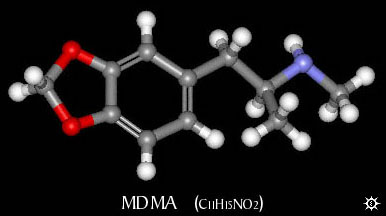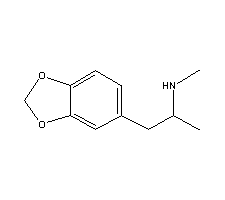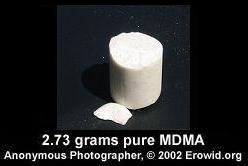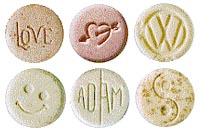   
      
also known as: E; X; XTC; Adam
The effects of a 120mg dose of MDMA are recorded in Dr Shulgin's lab-notes (Sept 1976):
"I feel absolutely clean inside, and there is nothing but pure euphoria. I have never felt so great or believed this to be possible. The cleanliness, clarity, and marvelous feeling of solid inner strength continued throughout the rest of the day and evening. I am overcome by the profundity of the experience..." ~ directly from http://www.mdma.net

~ graphic from the Vaults of Erowid
CHEMICAL NAME:
3,4-methylenedioxymethamphetamine
ALTERNATE CHEMICAL NAMES:
N, alpha-Dimethyl-1,3-benzodioxole-5-ethanamine
3,4-methylenedioxy-n-methylamphetamine
methylenedioxy-n-methylamphetamine
N-methyl-3,4-methylenedioxyphenylisopropylamine;
Structural Formula
 |
Molecular Formula
C11H15NO2
Origin
Synthetic.
Overview of Synthesis (method of isolation):
1. Distillation: of Natural Oil to obtain pure Safrole
2. Rxn: Formaldehyde + Ammonium Chloride -> MethylAmine.HCl (MeAm.HCl)
3. Rxn: Safrole -(Wacker Oxidation(PdCl2+Benzoquinone))-> MDP2P
4. Distillation: of Reaction contents to yield pure MDP2P
5. Rxn: MDP2P -(Al/Hg Amalgam (MeAm.HCl) -> MDMA oil
6. Crystallization: (MDMA oil + HCl in IPA/Xylene) (anhydrous conditions)
(From: BRIGHT STAR)
For a more detailed description (in fact an exact procedure of how to make mdma), go here.
Properties
MDMA fits into the chemical categories of entactogens and empathogens. (but is often called a hallucinogen, though it does not induce hallucinations)
MOLECULAR WEIGHT: 193.25 g.
MELTING POINT: 147-148¡ C (Hydrochloride crystals from isopropanol/n-hexane)
MELTING POINT: 152-153¡ C (Hydrochloride crystals from isopropanol/ether)
BOILING POINT: as oil: 100-110¡ C
COLOR: whitish powder
SOLUBILITY: mdma is not very soluble in water. |
 |
Intended function
MDMA is currently a Schedule I drug; that is, it is illegal in the US. Before it was made illegal in 1985, MDMA was used as a theraputic drug for patients suffering from post-traumatic stress disorder. Studies in search for evidence of MDMA's healing abilities as compared to its dangers are currently in progess. Because of its illegality, actual chemical effects and the possibility of neurotoxicity (brain damage) caused by mdma in humans is uncertain. There are many reports | backing both the positive and negative sides, however much of the research conducted is often bias. (NY Times abstract) The drug is sold in clubs and raves on the black market. Normal cost for pills sold as ecstasy usually range from $20 to $30. Public knowledge of the drug's actual effects has also been distorted by rumors from users unaware that many of the black market pills contain other drugs (such as speed, caffeine, LSD, etc.). | | 
~Pic from: Dancesafe.org |
While it is expected that these pills contain pure MDMA, this simply is not the case in 1 out of 3 pills tested by Dancesafe.org. A typical, prefered dose is usually around 120mg MDMA. Users take ecstasy to obtain the desired feelings of euphoria, which are caused by mdma's ability to cause the brain to release its stored serotonin. For a description of the latest theories on the neurochemistry of mdma visit this slideshow.
Common Myths:
Myth: Ecstasy is a date-rape drug. Fact: Liquid ecstasy, which is in fact NOT MDMA but a drug known as GHB, is a date-rape drug. At low GHB doses, users experience effects similar to that of alcohol. At high doses, users often experience "temporarily unrouseable sleep (sometimes characterized as a type of coma) for 1-4 hours. Some Overdoses of GHB mix vomiting with unconsciousness which is an extremely dangerous combination for obvious reasons." (Erowid) Rohypnol (a.k.a. a "roofie") is another date-rape drug. It is very potent (10 times more potent than Valium) and produces sedation, amnesia, muscle relaxation and a slowing of psychomotor responses within 20-30 minutes of ingestion, which can cause blackouts that can last from 8 to 24 hours. (from: Crime Prevention Association of Michigan)
MDMA is a stimulant and does not produce blackouts. As for the MDMA experience, "MDMA may feel mystical, magical or sublime; but it doesn't feel weird. The drug's influence feels highly controllable. MDMA tends to enrich the user's sense of self-identity, not diminish it. MDMA "provides a centering experience, rather than an ego diffusing experience" (Dr. Philip Wolfson), though it may also cause a "softening of the ego-boundaries". Sometimes a degree of derealisation on MDMA may occur, but rarely depersonalisation in the ordinary sense of the term. On the contrary, users feel they can introspectively "touch inside" to their ideal authentic self with total emotional self-honesty." (from: mdma.net) Ecstasy is often called a "hug-drug" since users experience a heightened sense of touch and feelings of empathy (emotional closeness to others), and therefore enjoy being close to one another while on it. MDMA most likely obtained this title as a date-rape drug due its "hug-drug" characteristics.
Myth: Ecstasy causes Parkinson's Disease (or can lead to symptom's similar to it.)
Fact: Dr. Ricaurte started this claim. It is retracted in this New York Times Article. MDMA researchers ridicule the thought saying, "Parkinson's disease is associated with cell death, not simply reductions in the dopamine system and this study did not find dopamine cells dying. Parkinson's researcher Sanchez-Ramos Ph.D., points out that even with the 'severe' damage to the dopamine system that Ricaurte found, there was still no cell death. 'He showed us very nicely that MDMA will kill an animal before it will kill a neuron,' a MAPS.org press release states." (Erowid) Not to mention, MDMA use has been wide spread since the 60s and it would have been suspected that these users would now have Parkinson's Disease. The number of cases of Parkinson's Disease is much, much less than the number of MDMA users - in the 60s or now, suggesting there is no link. Ironically, a report of ecstasy's ability to temporarily cure the symptoms of Parkinson's disease has been recorded: BBC News.
Real Dangers:
- MDMA is illegal and possession is a punishable offense.
- MDMA raises users' blood pressure and can potentially cause heart attacks in those known to have high blood pressure.
- MDMA is thought to trigger seizures in some people prone to have seizures.
- Street ecstasy pills often contain drugs besides MDMA. Some of these drugs are much more dangerous, especially when one is unaware of what they have ingested.
- MDMA dehydrates users, especially when combined with the constant dancing of the rave/club scene. Users should drink plenty of water BUT overhydration is a much more common cause of death of ecstasy users than dehydration. It is suggested that users drink water frequently, but at some point stop drinking and only swish and spit to avoid hyponatremia.
- The long-term effects of ecstasy use have yet to be determined. This does not in any way mean the drug is "safe." The less knowledge that is known, the more room there is for potential harm.
- MAOIs taken with MDMA may be fatal.
Frequency of Usage:
(From: cacrt.org)
A survey of frequency of MDMA usage among high school seniors and college students found that 9.2 percent of high school students surveyed had used MDMA at least once in 2001, and 9.1 percent of college students had used MDMA at least once in 2000. (Ibid.)
Effects of the drug include:
(From: the Vaults of Erowid)
Positive:
extreme mood lift, physical pain relief,
increased willingness to communicate,
increase in energy (stimulation),
ego softening,
feelings of comfort, belonging, and closeness to others,
feelings of love and empathy,
forgiveness,
increased awareness & appreciation of music,
increased awareness of senses. (eating, drinking, smell),
profound life-changing spiritual experiences,
neurotically based fear dissolution,
sensations bright and intense
Neutral:
appetite loss, pupil dialation,
moderately increased heart rate and blood pressure (increases with dose),
restlessness, nervousness, shivering,
change in body temperature regulation,
strong desire to do or want more when coming down, Negative:
inappropriate and/or unintended emotional bonding,
tendency to say things you might feel uncomfortable about later,
mild to extreme jaw clenching (trisma), tongue and cheek chewing, and teeth grinding (bruxia),
difficulty concentrating & problems with activities requiring linear focus,
short-term memory scramble or loss & confusion,
muscle tension,
erectile disfunction and difficulty reaching orgasm,
increase in body temperature, hyperthermia, dehydration (drink water),
hyponatremia (don't drink too much water)
Some people may experience:
nausea and vomiting, rapid, involuntary eye jiggling (nystagmus), headaches, dizziness, loss of balance, and vertigo,
post-trip Crash - unpleasantly harsh comedown from the peak effect,
hangover the next day, lasting days to weeks,
mild depression and fatigue for up to a week,
severe depression and/or fatigue (uncommon),
possible strong urge to repeat the experience, though not physically addictive,
possible psychological crisis requiring hospitalization (psychotic episodes, severe panic attacks, etc) (rare),
possible liver toxicity (rare),
possible neurotoxicity (controversial),
small risk of death. Approximately 2 per 100,000 users have extreme negative, reactions resulting in death. (rare)
Information and some graphics used from the following websites:
http://www.rhodium.ws/chemistry/brightstar.mdma.html
http://www.erowid.org/chemicals/mdma/mdma.shtml
http://www.mdma.net/
http://www.webdiner.com/
http://www.iconbazaar.com
http://www.dancesafe.org/documents/druginfo/ecstasy.php
|













